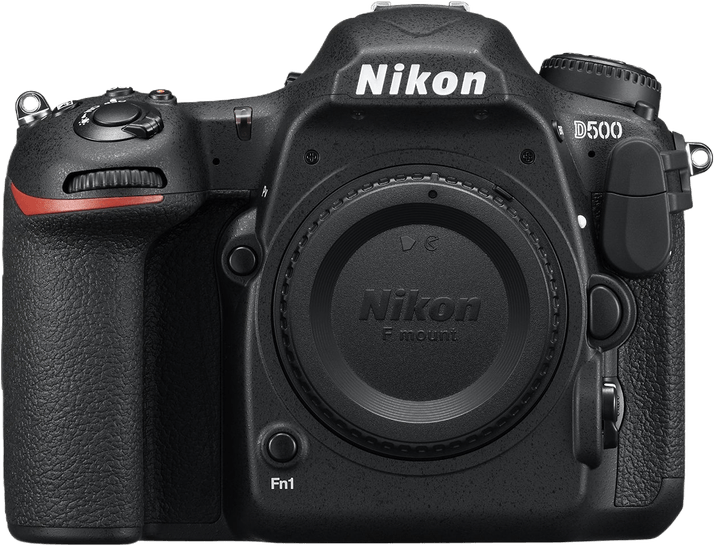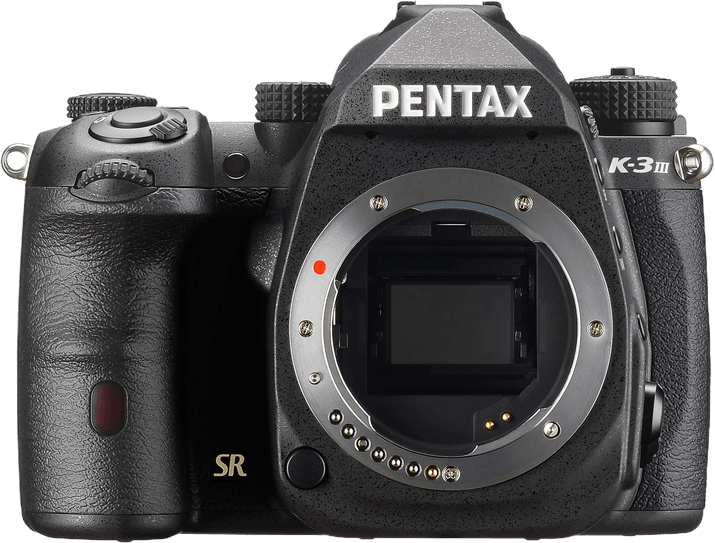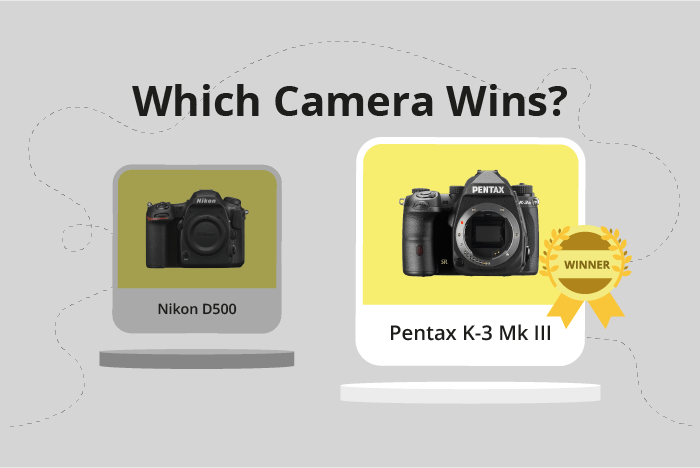Nikon D500 vs Pentax K-3 Mark III Comparison
Nikon D500

Pentax K-3 Mark III

The Pentax K-3 Mark III outperforms the Nikon D500 with a score of 83/100 compared to the D500’s 75/100. Both cameras are DSLRs, announced in 2021 and 2016 respectively, and share a similar launch price of around $2000.
The Pentax K-3 Mark III is smaller and lighter, measuring 135 x 104 x 74mm and weighing 820g, while the Nikon D500 measures 147 x 115 x 81mm and weighs 860g. This makes the Pentax more portable and convenient for photographers on the go.
However, the Nikon D500 has its advantages as well. Being an older model, it has a longer track record and a more established user base, which can be helpful for support and community advice.
Considering the specifications, the Pentax K-3 Mark III is the clear winner due to its higher score, smaller size, and lighter weight. Nevertheless, the Nikon D500 remains a viable option for those who value the benefits of an established camera model.
Nikon D500 vs Pentax K-3 Mark III Overview and Optics
The Pentax K-3 Mark III outperforms the Nikon D500 in optics with a score of 82/100, compared to the Nikon D500’s score of 69/100. This 13-point difference is significant when comparing the cameras’ optical capabilities.
Both cameras share some common specifications, including a CMOS sensor, an APS-C sensor size, and compatibility with their respective lens mounts – Nikon F DX for the D500 and Pentax KAF2 for the K-3 Mark III. However, the similarities end there, with the Pentax K-3 Mark III offering superior features in other areas.
The Pentax K-3 Mark III has a higher megapixel count at 26, compared to the Nikon D500’s 20.9, allowing for more detailed and high-resolution images. Additionally, the K-3 Mark III boasts a faster shooting speed of 12 frames per second, as opposed to the D500’s 10 frames per second. The Pentax K-3 Mark III also has a higher DXOMARK score for its sensor at 96, compared to the Nikon D500’s score of 84, indicating better overall image quality.
The Nikon D500, on the other hand, features an Expeed 5 processor, which may provide faster processing and better noise reduction. However, this advantage is not enough to overcome the Pentax K-3 Mark III’s superior optical performance.
One notable feature that sets the Pentax K-3 Mark III apart is its built-in image stabilization, which the Nikon D500 lacks. This feature helps to reduce camera shake and produce sharper images, especially in low-light situations or when using slower shutter speeds.
Considering the significant differences in optical performance, the Pentax K-3 Mark III is the clear winner in this comparison. With its higher megapixels, faster shooting speed, better sensor score, and built-in image stabilization, the K-3 Mark III is a more capable camera for capturing high-quality images. While the Nikon D500 may have a slightly faster processor, it falls short in other critical areas, making the Pentax K-3 Mark III the better choice for photographers seeking superior optics.
Nikon D500 vs Pentax K-3 Mark III Video Performance
The Pentax K-3 Mark III emerges as the winner in video capabilities with a score of 83/100, compared to the Nikon D500’s score of 70/100. Both cameras share common specifications, such as a maximum video resolution of 4K, maximum video dimensions of 3840 x 2160, and built-in time-lapse functionality.
The Pentax K-3 Mark III outperforms the Nikon D500 in terms of video frame rate, offering a maximum of 60fps, while the Nikon D500 only supports up to 30fps. This difference allows the Pentax K-3 Mark III to capture smoother and more detailed videos, making it a superior choice for videographers who prioritize high-quality footage.
On the other hand, the Nikon D500 does not have any notable advantages in video capabilities over the Pentax K-3 Mark III. Both cameras share the same 4K resolution, video dimensions, and time-lapse features, and the Nikon D500 falls short with its lower frame rate.
Taking these points into consideration, the Pentax K-3 Mark III proves to be a better choice for video enthusiasts due to its higher video score and superior frame rate. The Nikon D500, while still a capable camera, does not provide any additional benefits in the video aspect when compared to the Pentax K-3 Mark III. Therefore, those looking for a camera with strong video capabilities should opt for the Pentax K-3 Mark III.
Nikon D500 vs Pentax K-3 Mark III Features and Benefits
The Nikon D500 and Pentax K-3 Mark III both have a feature score of 87 out of 100, indicating that these cameras are quite similar in terms of features. Both cameras have a 3.2-inch touchscreen, GPS, WIFI, and Bluetooth capabilities. However, there are some differences that make each camera stand out in its own way.
The Nikon D500 has a higher screen resolution of 2,359,000 dots compared to the Pentax K-3 Mark III’s 1,620,000 dots. This means the Nikon D500 provides a clearer and more detailed image preview on its screen. Another advantage of the Nikon D500 is the presence of a flip screen, which allows for more versatile shooting angles and is particularly useful for vlogging or taking selfies.
On the other hand, the Pentax K-3 Mark III does not have a flip screen, which may limit its versatility in certain shooting situations. However, it is worth mentioning that both cameras still offer a high-quality touchscreen display, making it easy to navigate through menus and adjust settings.
In terms of features, both the Nikon D500 and the Pentax K-3 Mark III are quite comparable, with the main differences being the screen resolution and the presence of a flip screen on the Nikon D500. These differences may influence a photographer’s decision, depending on their specific needs and preferences. While the Nikon D500 has a slight edge in terms of screen quality and versatility, both cameras still offer a solid set of features that cater to a variety of photography styles and requirements.
Nikon D500 vs Pentax K-3 Mark III Storage and Battery
The Pentax K-3 Mark III takes the lead in storage and battery with a score of 81/100, while the Nikon D500 trails with 79/100. Both cameras feature two memory card slots and accept SD, SDHC, and SDXC cards. However, the Nikon D500 is UHS-II compatible and also supports XQD cards, providing faster performance and larger storage capacity.
In terms of battery life, the Nikon D500 outperforms the Pentax K-3 Mark III with 1240 shots, compared to 800 shots. The D500 uses an EN-EL15 battery, while the K-3 Mark III uses a D-LI90 battery. Although the D500 has a longer battery life, the K-3 Mark III offers USB charging, allowing for more convenient charging options.
Considering these factors, the Pentax K-3 Mark III has a slight advantage in storage and battery due to its USB charging capability. However, the Nikon D500 offers better battery life and faster memory card performance, making it a strong contender in this category.
Alternatives to the Nikon D500 and Pentax K-3 Mark III
Are you still undecided about which camera is right for you? Have a look at these popular comparisons that feature the Nikon D500 or the Pentax K-3 Mark III:

